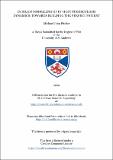Files in this item
In silico modelling of in-host tuberculosis dynamics : towards building the virtual patient
Item metadata
| dc.contributor.advisor | Dobson, Simon | |
| dc.contributor.author | Pitcher, Michael John | |
| dc.coverage.spatial | xxxiii, 209 p. | en_US |
| dc.date.accessioned | 2020-03-02T14:34:46Z | |
| dc.date.available | 2020-03-02T14:34:46Z | |
| dc.date.issued | 2020-06-24 | |
| dc.identifier.uri | https://hdl.handle.net/10023/19575 | |
| dc.description.abstract | Tuberculosis (TB) accounts for over 1 million deaths each year, despite effective treatment regimens being available. Improving the treatment of TB will require new regimens, each of which will need to be put through expensive and lengthy clinical trials, with no guarantee of success. The ability to predict which of many novel regimens to progress through the clinical trial stages would be an important tool to TB research. as current models are constrained in their ability to reflect the whole spectrum of pathophysiology, particularly as there remains uncertainty around the events that occur. This thesis explores the use of computational techniques to model a pulmonary human TB infection. We introduce the first in silico model of TB occurring over the whole lung that incorporates both the environmental heterogeneity that is exhibited within different spatial regions of the organ, and the different bacterial dissemination routes, in order to understand how bacteria move during infection and why post-primary disease is typically localised towards the apices of the lung. Our results show that including environmental heterogeneity within the lung can have profound effects on the results of an infection, by creating a region towards the apex which is preferential for bacterial proliferation. We also present a further iteration of the model, whereby the environment is made more granular to better understand the regions which are afflicted during infection, and show how sensitivity analysis can determine the factors that contribute most to disease outcomes. We show that in order to simulate TB disease within a human lung with sufficient accuracy, better understanding of the dynamics is required. The model presented in this thesis is intended to provide insight into these complicated dynamics, and thus make progress towards an end goal of a virtual clinical trial, consisting of a heterogeneous population of synthetic virtual patients. | en_US |
| dc.description.sponsorship | "“This work was supported by the PreDiCT TB consortium (IMI Joint undertaking grant agreement number 115337, resources of which are composed of financial contribution from the European Union’s Seventh Framework Programme (FP7/2007-2013) and EF-PIA companies’ in kind contribution.)” -- Acknowledgements | en |
| dc.language.iso | en | en_US |
| dc.publisher | University of St Andrews | |
| dc.relation | Pitcher, M. J., Bowness, R., Dobson, S., & Gillespie, S. H. (2018). A spatially heterogeneous network-based metapopulation software model applied to the simulation of a pulmonary tuberculosis infection. Applied Network Science, 3(1). https://doi.org/10.1007/s41109-018-0091-2 | en_US |
| dc.relation | Pitcher, M. J., Bowness, R., Dobson, S., Eftimie, R., & Gillespie, S. H. (2019). Modelling the effects of environmental heterogeneity within the lung on the tuberculosis life-cycle. BioRxiv. https://doi.org/10.1101/2019.12.12.871269 | en_US |
| dc.relation.uri | https://doi.org/10.1007/s41109-018-0091-2 | |
| dc.relation.uri | https://doi.org/10.1101/2019.12.12.871269 | |
| dc.rights | Creative Commons Attribution-NonCommercial 4.0 International | * |
| dc.rights.uri | http://creativecommons.org/licenses/by-nc/4.0/ | * |
| dc.subject | Tuberculosis | en_US |
| dc.subject | Systems biology | en_US |
| dc.subject | Network modelling | en_US |
| dc.subject | Sensitivity analysis | en_US |
| dc.subject | Computational biology | en_US |
| dc.subject | Lung | en_US |
| dc.subject | Metapopulation | en_US |
| dc.subject.lcc | QH324.2P5 | |
| dc.subject.lcsh | Systems biology | en |
| dc.subject.lcsh | Tuberculosis--Research | en |
| dc.subject.lcsh | Tuberculosis--Treatment | en |
| dc.subject.lcsh | Lungs--Computer simulation | en |
| dc.title | In silico modelling of in-host tuberculosis dynamics : towards building the virtual patient | en_US |
| dc.type | Thesis | en_US |
| dc.contributor.sponsor | PreDiCT-TB Consortium | en_US |
| dc.contributor.sponsor | Seventh Framework Programme (European Commission) | en |
| dc.type.qualificationlevel | Doctoral | en_US |
| dc.type.qualificationname | PhD Doctor of Philosophy | en_US |
| dc.publisher.institution | The University of St Andrews | en_US |
| dc.identifier.doi | https://doi.org/10.17630/10023-19575 |
The following licence files are associated with this item:
This item appears in the following Collection(s)
Except where otherwise noted within the work, this item's licence for re-use is described as Creative Commons Attribution-NonCommercial 4.0 International
Items in the St Andrews Research Repository are protected by copyright, with all rights reserved, unless otherwise indicated.


